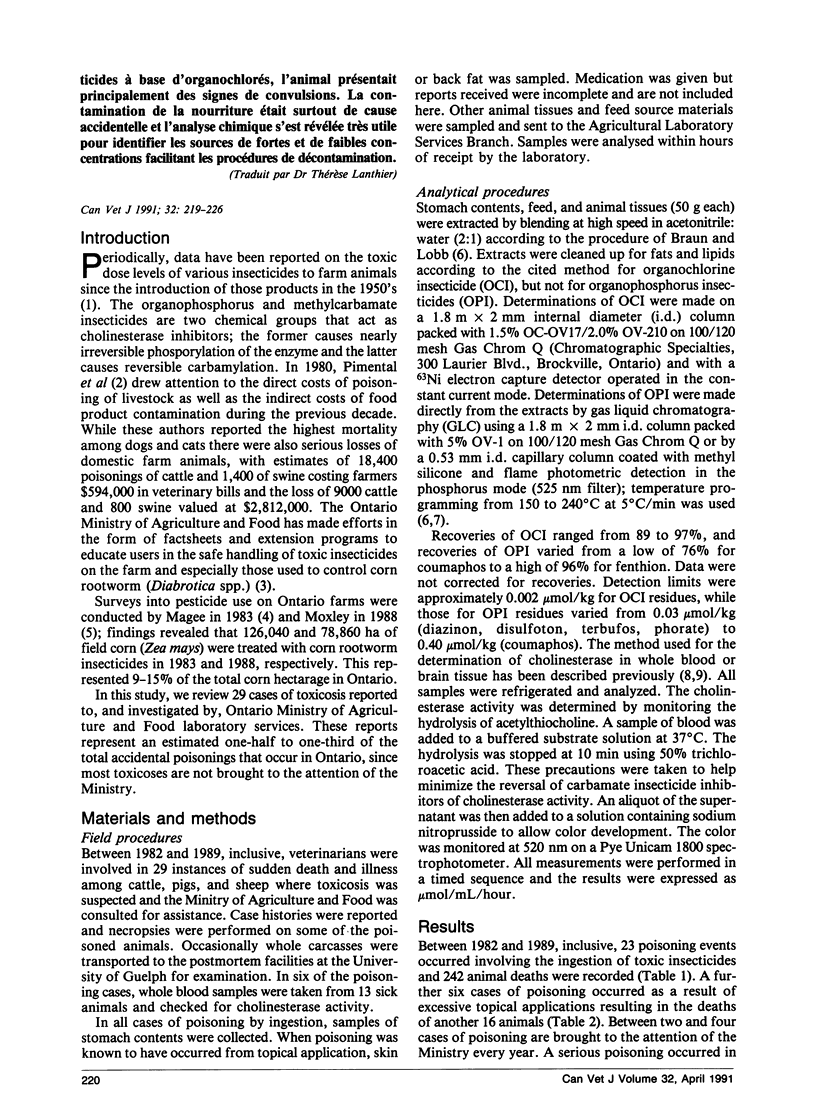Abstract
From 1982 to 1989, inclusive, 20 poisonings were investigated by the Ontario Ministry of Agriculture and Food following ingestion by domestic livestock of granular insecticides including terbufos (13 poisonings), disulfoton (two poisonings), fonofos (two poisonings), phorate (two poisonings), and carbofuran (one poisoning); all are used for rootworm (Diabrotica spp.) control in corn. A further three poisonings of livestock occurred following the ingestion of the foliar insecticide, endosulfan (two poisonings), and the seed protectant insecticides diazinon plus lindane (one poisoning). There were six poisoning cases as a result of excessive topical applications of the three insecticides coumpahos, fenthion, and lindane as dusts or sprays to control external parasites. Together, these events caused the deaths of 258 domestic animals of which 200 were cattle, 23 were swine, and 35 were sheep. Not all deaths are reported to the Ministry and the cases reported here may only represent 30-50% of the actual deaths over the period. Based on total populations of livestock, the percent losses were very small but they represent serious losses to individual growers. The economic loss is estimated at $160,000 over the eight years, or $20,000 per annum, and this does not include veterinary costs.
Some of the poisoned animals died within as little as three to four hours of ingestion while others were sick but survived for several days. Lethal doses of insecticide were found in the rumen, abomasum, or stomach of dead animals. Signs typical of cholinesterase inhibition caused by organophosphorus poisoning were observed in most cases. Cholinesterase readings were found to be zero in dying animals. Necropsy findings were rarely more than pulmonary edema or myocardial hemorrhage. Where organochlorine insecticides were ingested, convulsions were the major manifestation.
Contamination of feed was most often accidental, and chemical analysis was most helpful in identifying both potent and minor sources, thus facilitating cleanup procedures.
Full text
PDF





Selected References
These references are in PubMed. This may not be the complete list of references from this article.
- Boermans H. J., Black W. D., Chesney J., Robb R., Shewfelt W. Terbufos poisoning in a dairy herd. Can Vet J. 1984 Sep;25(9):335–338. [PMC free article] [PubMed] [Google Scholar]
- Frank R., Braun H. E. Lindane toxicity to four-month-old calves. Bull Environ Contam Toxicol. 1984 May;32(5):533–536. doi: 10.1007/BF01607533. [DOI] [PubMed] [Google Scholar]
- GARRY P. J., ROUTH J. I. A MICRO METHOD FOR SERUM CHOLINESTERASE. Clin Chem. 1965 Feb;11:91–96. [PubMed] [Google Scholar]
- Harrison D. L. Veterinary aspects of insecticides: organochlorines. N Z Vet J. 1971 Oct;19(10):227–232. doi: 10.1080/00480169.1971.33973. [DOI] [PubMed] [Google Scholar]
- Solly S. R. Veterinary aspects of insecticides: organophosphates. N Z Vet J. 1971 Oct;19(10):233–240. doi: 10.1080/00480169.1971.33974. [DOI] [PubMed] [Google Scholar]


